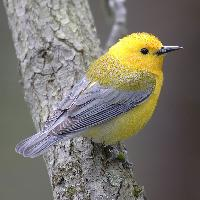
Poids et mesures
| Longueur | 13 cm |
|---|---|
| Poids | 12,5 g |
Description de l'animal
The Prothonotary Warbler (Protonotaria citrea) is a small, striking songbird that belongs to the family Parulidae, which encompasses the diverse group of New World warblers. This species is particularly notable for its vibrant plumage and melodious song, characteristics that make it a favorite among birdwatchers and nature enthusiasts. The Prothonotary Warbler is named after the bright yellow robes worn by protonotaries, clerks in the Roman Catholic Church, a nod to the bird's vivid yellow body.Physical Description
Adult Prothonotary Warblers have a length of approximately 5.1 to 5.5 inches (13 to 14 cm) and a wingspan ranging from 8.7 to 9.8 inches (22 to 25 cm). Males and females exhibit some degree of sexual dimorphism, primarily in their color intensity. Males boast a brilliant yellow or golden body that gleams in the sunlight, with contrasting blue-gray wings and back that can appear almost greenish in certain lights. Their tails are also blue-gray, and they have a striking white undertail. The face of the male is adorned with a blue-gray cap, and it has a sharp, black beak. Females, while also yellow, tend to have a slightly duller hue compared to the males and may show less blue-gray on the back and wings.
Habitat and Distribution
Prothonotary Warblers are primarily found in the eastern United States during the breeding season, particularly in hardwood swamps, flooded forests, and mangrove swamps along the Gulf Coast. They prefer habitats with abundant standing water, especially those that contain willow, cypress, or other water-tolerant trees. During migration, they can be observed in a variety of forested or shrubby habitats. In the winter months, these warblers migrate to Central and South America, where they inhabit tropical forests, mangroves, and wooded areas near water.
Behavior and Diet
Prothonotary Warblers are cavity nesters, a rare trait among warblers. They often use old woodpecker holes or artificial nest boxes close to or over water. This adaptation allows them to reduce the threat of predation. Their diet primarily consists of insects and other invertebrates, although they may occasionally consume small fruits and seeds. They typically forage alone or in pairs, gleaning prey from tree trunks, branches, and leaves, often close to the water's surface.
Reproduction
The breeding season begins in late April and extends through July. Females lay between 3 to 7 eggs, which are incubated for about 12 to 14 days. The chicks are altricial, meaning they are born blind and featherless, completely dependent on their parents for food and protection. Both parents share in feeding the chicks, which fledge approximately 10 to 11 days after hatching but remain dependent on their parents for a few more weeks.
Conservation Status
The Prothonotary Warbler is currently listed as Least Concern by the IUCN, indicating that it is not at immediate risk of extinction. However, like many species, it faces threats from habitat destruction, particularly the loss of wetland habitats due to development, pollution, and climate change. Conservation efforts aimed at preserving and restoring suitable wetland habitats are crucial for the long-term survival of this species.
Cultural Significance
Beyond its ecological role, the Prothonotary Warbler has garnered admiration for its beauty and the vibrancy it brings to its habitats. Birdwatchers often seek out this species for its striking appearance and sweet song. Its presence and behavior continue to contribute to scientific understanding and environmental awareness, highlighting the importance of wetland conservation for biodiversity.
In summary, the Prothonotary Warbler is a vibrant, melodious bird whose life cycle and habits are closely tied to wetland ecosystems. Its beauty and rarity make it a species of interest both for conservation efforts and for those who take pleasure in the richness of North American birdlife.
Animaux similaires
Nouvelles photos d'animaux
Top 10 des animaux
- Dolphin gull (Leucophaeus scoresbii)
- Diana monkey (Cercopithecus diana)
- Moustached guenon (Cercopithecus cephus)
- Galápagos tortoise (Geochelone nigra complex)
- Russian tortoise (Testudo horsfieldii)
- Stone loach (Barbatula barbatula)
- Japanese macaque (Macaca fuscata)
- Common flying dragon (Draco volans)
- Greek tortoise (Testudo graeca)
- Vendace (Coregonus albula)
